The Razer Blade Review
by Vivek Gowri & Jarred Walton on March 15, 2012 3:01 AM ESTAnd so, we arrive at the Switchblade panel, which resides to the right of the keyboard. This is Razer’s crown jewel, the Blade’s pièce de résistance, and probably the coolest feature we've seen on a notebook computer in a very long while. And I truly mean that.
Switchblade starts with 10 LCD tiles arranged in a five by two grid above the LCD touchpad. Razer calls them Dynamic Adaptive Tactile keys, a fancy way of saying that the keys have individually customizable LCDs that users can change as they see fit. Think about a miniature Art Lebedev Optimus built into your laptop; the word awesome doesn’t quite do justice to how awesome it actually is. The keys are 15mm x 15mm squares with 115x115 resolution, and you can get up to 10 pages of custom shortcuts. I can’t imagine what one would do with 100 different shortcuts, but I suppose someone out there has a need for it.
The touchpad is similarly interesting. It’s a 4.05” capacitive multitouch unit with a resolution of 800x480. The relocation to the right of the keyboard requires some mental recalibration, but after the second day, it feels completely natural. The positioning makes gaming on a touchpad much easier—it’s significantly more intuitive attempting to game on a standard touchpad below the keyboard. Granted, it still won’t get anywhere near the experience with a real mouse, but it’s livable, unlike the touchpad norm, which is a lot closer to laughable. The Synaptics multitouch drivers have support for the main multitouch gestures—two finger scroll, pinch to zoom, and rotation—along with three finger horizontal swipes for front/back (or switching between pages of the dynamic keys, depending on what Switchblade mode you’re in).
As a touchpad in day to day use, it works quite well—think using a smartphone as a touchpad, and you’ve got the right idea. The surface is glossy, which I personally didn’t have an issue with, but Razer includes a matte finish screen protector in the box for the people that don’t like their trackpads quite as smooth. At first, the glass has a bit too much friction, but it gets easier to use over time. The gestures are pretty smooth, especially vertical scrolling. This is one of the few Windows notebooks that has a relatively smooth multitouch scroll, though still not as smooth as the physics-accelerated scrolling in OS X. The only minor complaints I have with the functions are related to the mouse buttons—I don’t like how the glossy plastic visually contrasts against the matte interior, and the click itself doesn’t have fantastic feedback. You know when I said there’s nothing about the Blade that looks or feels cheap? The mouse buttons are the exception to that statement, though overall they’re a trifling issue at most.
Switchblade ships with ten apps—the standard trackpad mode with 10 user-assignable keys, .a numberpad, a macro recorder, gaming mode (trackpad off, certain keys disabled), a mobile browser, YouTube, Facebook, Twitter, Gmail, and a clock. Switching between them is pretty simple—hit the Razer button at the bottom right corner of the keyboard and you’ll go back to the Switchblalde home page, from which you can launch another app. You can define different sets of shortcuts for different keyboard profiles, for example in different games. You can select custom icons for the user-defined shortcuts—Razer includes an icon set for Star Wars: The Old Republic (the Switchblade UI is also available as a standalone peripheral in the SW:TOR gaming keyboard), but any image file can be selected, even high-res JPEG images. Unfortunately, Windows ICO files don’t seem to be usable, which makes life a little bit more difficult.
The number pad, macro recorder, gaming mode, and clock are all pretty explanatory. The clock doesn’t have any other functions—no timer or stopwatch to speak of, unfortunately. Gmail, Facebook, Twitter and YouTube just bring up mobile versions of those sites; however, it’s relatively non-optimal because of the browser being used. The browser user agent identifies it as “Browser User Agent String: Mozilla/4.0 (compatible; MSIE 7.0; Windows NT 5.1; Trident/3.1; IEMobile/7.0)”, and from the digging I did it appears to be a version of IE7 running on an embedded Windows XP. and it’s quite simply not great. Compared to the WebKit-based browsers in recent smartphones, it’s relatively poor. JavaScript seems to be disabled, because SunSpider doesn’t run and Acid3 throws an error message about scripting being disabled. The browser scores 40 in the HTML5 test. But even functionally, the browser isn’t optimized—it doesn’t have bookmarks, and it doesn’t stay on the page you last used—every time you exit the browser application and reopen it, it goes to the RazerZone webpage, and forces you to navigate from there. It’s usable in a pinch, but you’re almost better off browsing on any other mobile device.
Switchblade is very much tied to Razer’s Synapse service, using the configuration software to change settings of the dynamic LCD keys and keyboard, as well as managing macros and backlighting. You first need to create an account and sign in to access the Switchblade apps; Synapse will automatically sign in on boot, even without an internet connection. It’s a pretty intuitive software to use, but it appears as though the software isn’t particularly stable yet. At first I had some issues with Synapse crashing, but reinstalling the driver for the Switchblade panel seemed to fix it. There are still some quirks—Switchblade had some issues with coming out of standby, though resetting the profile in Synapse fixes that. Very occasionally, the entire system kills itself, with the LCD keys going white and the keyboard and mouse going unresponsive, in which case, a reboot is necessary. The minor instabilities aren’t a big issue, because they’re far and few between, but the issues coming out of sleep are definitely more so, because it happens almost every time. It’s also worth noting that not all users reported having these issues, but I’m not the only one to have them, so real-world mileage may vary.
The keyboard is an interesting proposition. It’s fully anti-ghosted, is backlit in Razer green, and appears to be designed with aesthetics in mind. Every single key can be reassigned in Synapse, including letter keys and everything else. Want comedy? Reassign all the keys to random letters and then hand the Blade to a friend. The keyboard is really nice to look at—the font used is squared off, like a Pac-Man era arcade game, and there are some touches like the E, W, and M keys being the same and rotated differently (along with the R and L keys, the Z and N keys, etc), playing off the geometric properties of the letters. It’s fun, it’s stylish, and it simply looks cool. In use, it’s not as rosy. There’s not much key travel, though Razer’s reasoning for this is that the shorter key depth means the keyboard is more responsive in gaming situations. Which makes sense, but unfortunately, when typing an 8000 word review, it doesn’t feel as great. I switched from the Blade to a ThinkPad for an afternoon, and every key felt like a bottomless pit. Keyboards are based to some degree on preference, and while I don’t have a problem with shallower keys, I feel like Razer takes that a little bit farther than I would like. On the good side, there’s no flex and the whole thing feels solid.
But the layout as a whole is a bit messed up. I’ve had laptops with the function key in the left corner, some with it on the other side of the control key, and I’ve usually been completely okay with all of them. The Blade is the first time I’ve really had an issue with Fn key placement—it’s a surprisingly annoying ergonomic detail to get used to. Having the function key on the right side of the space bar just seems contrary to logic. Other quibbles: the right and left arrow keys are full height, while the up and down keys are half height; the unevenness is offputting. I wish they would have just borrowed the Apple way and gone with half height keys in all four directions. The other issue is that while the keys are backlit, the secondary functions of the F-keys aren’t, so unless you have them memorized, you end up fumbling with keys in the dark to turn the brightness down or change the volume. Just minor details, all of them, but they do pose a few usability issues I hope that Razer will fix next time around.


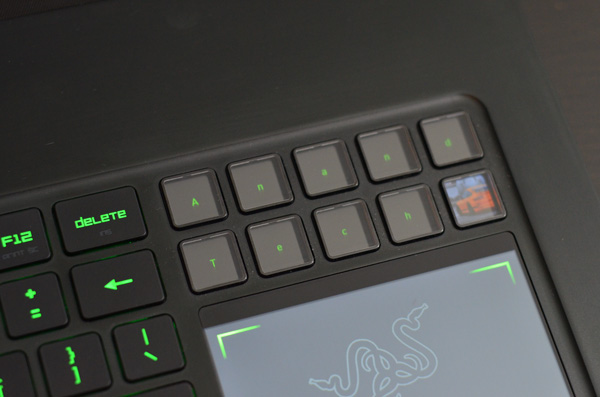

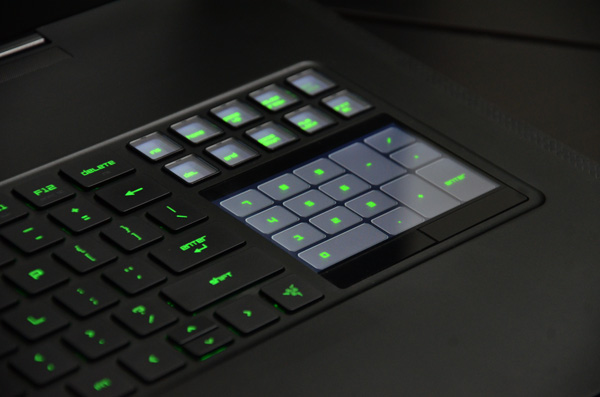
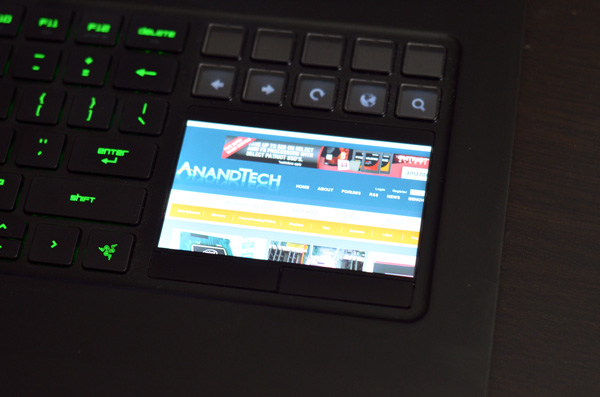
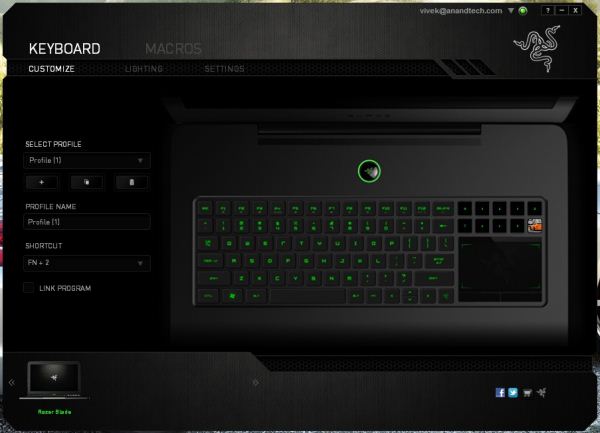
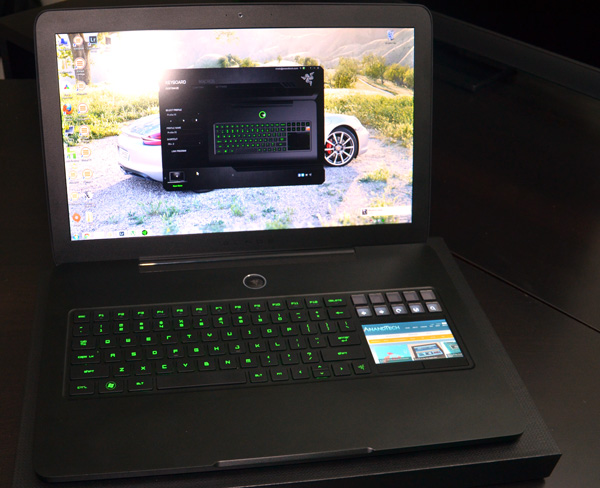








95 Comments
View All Comments
niva - Thursday, March 15, 2012 - link
That system is indeed interesting. I'm really looking forward to seeing what other machines they'll put out in the future. I'm not interested in the Switchblade, but the design of this machine highly appeals to me. The usage of the black and green details, the glowing kb... very nice Razer. Now I wish I could afford something like this...Thefinaleofseem - Friday, March 16, 2012 - link
The most hilarious thing about this laptop? It's arguably more overpriced than a 17" Macbook Pro. Compare the specs. 6770M vs 555M. They're about the same. 1080p panels with the MBP arguably having a better panel, similar form factors and weight. The Blade actually went with a bloody dual core when the MBP has a quad that turbos to about the same frequency anyway. It does have an SSD, which is a welcome change over the laughable 320GB hard drive they used to have in there and actually gives it a solid edge. It does have 8GB of RAM, although if you buy RAM anywhere other than Apple, you can get 8GB for less than $40, so that's hardly an issue.That leaves the little touchpad and a few extra buttons. Sorry, but that screen is little more than a gimmick. A touchpad with no tactile feedback? Utterly useless in gaming, which is the market that Razer is looking to grab with this thing. Have fun looking away from the screen periodically to ensure that your fingers are in the right place. It might be somewhat useful in slower/turn-based games, but nothing even remotely fast paced will have a use for it.
The only solid advantage it has is the SSD. The major disadvantage it has is the laughable dual core CPU. Really, in a game that can use perhaps only two cores, the difference will be minute if it's even visible at all. In games that can use a quad? The MBP will pull ahead easily, not to mention if you're running multiple other applications with your games or want to do something else, like media compression. That leaves the SSD, which is nice, but quite frankly, when you're about on the level of what many consider to be the poster boy for overpriced, then maybe you're charging too bloody much.
santiagodraco - Sunday, March 18, 2012 - link
I agree with much of what's you've said and also agree that this thing has missed it's mark (but as a notebook per se it's very cool).As for the trackpad... well that's really a non issue as anyone who calls themselves a gamer wouldn't be caught dead using a trackpad, they'll have a mouse in the bag. So from that perspective the trackpad is very cool as an information display but nothing else.
Hrel - Thursday, March 15, 2012 - link
How can you claim to be about gamers when you put a GT540 in a 17" Chassis? Psh, doesn't even count. With that price tag I expected AT LEAST a GTX560, if not GTX570. Don't get me wrong, I like the idea of trying to make this type of laptop less cumbersome. But right now I can't imagine playing on anything less than the GTX560M, which I have currently in my Clevo. Overall I'm very happy with it, but I'd pay an extra 500 bucks to have a second hdd bay and cut the bulk by half. As for the specs this is as low as I'm willing to go. Get rid of the cd rom drive, fine. I honestly couldn't care any less about that. But the GT540M is unacceptable; I'm sorry. It's nice that this is thin, but I'll put up with a little extra bulk and weight to have a GPU I can actually use. If you have to do that by putting the GPU in an external "caddie" or docking station I'm fine with that too. As I don't ever game on battery power, only when it's plugged in.Razer, I say develop a docking station using Intels lighpeak connection and some good ol USB 3.0, and make that dock compatible with every single laptop you release, period. THAT! My friends will garner some serious customer loyalty.
Hrel - Thursday, March 15, 2012 - link
I look forward to the day when I can just slide my smartphone into my laptop, where that touchpad is now. One concern though, I have a friend who because of a skin condition cannot use anything that's capacitive touch. I'm sure this is a small segment of their target customers but every time I see capacative touch on stuff I think of that now.Hrel - Thursday, March 15, 2012 - link
hm, see that's another things, especially for this much money, I expect to work properly. Noise, I never notice the noise of my Clevo P151. If I listen for it I can hear it, but I do not ever notice it. I paid 1100 bucks for this thing, then put a Seagate Hyrbrid drive in it. Beautiful 1080p screen. For nearly 3 times that I expect everything to be better in every single way. The physical size of the laptop just doesn't matter if it means sacraficing anything else at all about the laptop. I'd rather have a 20lb monster that runs everything I play at 1080p and doesn't make a peep than a 6lb pansy that can't even play Mass Effect 1 at 1080p smoothly. Like the SSD, ok, load times are low. That's nice. That's why I have the hybrid drive. But really I care much more about the performance IN THE application that I do how long it takes to load that application. It's a luxury item, like the size of the laptop, nice to have and I'm one of those people who are willing to pay extra for that kind of thing; I have the means. I'm just not willing to sacrafice another area of the laptop to get it. I do like the design elements and apparent attention to detail quite a lot. This looks like an excellent first try, they just got too ambititious and sacraficed on fundamentals; in my opinion. Also the price seems about 800 too high given the specs. And that's assuming noise was a non-issue.owan - Thursday, March 15, 2012 - link
We get it. You want gaming performance, you're willing to carry around a desktop with a screen bolted on. Thats great, but you're not who this laptop is for. I agree that their marketing department made a mistake saying this was "for gamers" but you don't have to harp on it.Immentus - Thursday, March 15, 2012 - link
Sure it is. It's aimed very much for him - it's a gaming laptop. Many of his points are valid considerations. Maybe you should focus on educating yourself rather than trying make your skittle fan boy comments sound valid.Hrel - Thursday, March 15, 2012 - link
Lol, you sir just made my day! Thank you.tim851 - Friday, March 16, 2012 - link
Not every gaming laptop is aimed at every gamer. That would be nigh impossible.Hrel is obviously looking for a desktop replacement, something you don't lug around every day. That's why he can live with the drawbacks, i.e. size and weight.
Just because other gamers put more emphasis on portability and are willing to sacrifice top performance for it doesn't make them less of a gamer or a solution aimed at them less of a gaming laptop.
There are still people playing competitive Counter-Strike or StarCraft (1) and let's not forget the millions of people living in World of Warcraft or other online games. These people are gamers, yet don't need the utmost performance.
And some might welcome the style appeal in the Blade, which is obviously meant for people who like the MacBook Pro's design, but for whatever reason don't want one or a clone.
So here you get the same form factor and internals in a surprisingly discrete and different design.